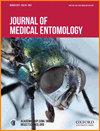评估区域单位选择和可修改区域单位问题对蜱传疾病病例与昆虫学指数之间关联统计的影响
IF 2
3区 农林科学
Q1 ENTOMOLOGY
引用次数: 0
摘要
可变空间单位问题(MAUP)是根据空间单位汇总数据时产生统计和视觉偏差的一个原因,尤其是当空间单位可以任意改变时。在病媒传染病研究中,当根据点级采样数据收集的昆虫学指标与汇总到行政单位(如县或邮政编码)的流行病学数据相关联时,MAUP 是一个值得关注的问题。在此,我们在计算 2017 年纽约州随机汇总的无形体病例与 2017 年秋季收集的黑脚蜱(Ixodes scapularis Say, Acari: Ixodidae)中噬细胞无形体昆虫学风险指数的地理统计层之间的相关性时,评估了 MAUP 的统计影响。我们还使用不同的行政边界计算了相关性,以进行比较。我们还展示了 MAUP 对使用choropleth 地图进行数据可视化的影响,并提供了 pycnophylactic 插值作为替代方法。多边形模拟表明,多边形数量的增加会降低相关系数及其变异性。使用邮政编码制表区和人口普查区多边形计算的相关系数与模拟相关系数的平均值相差 4 个标准差以上。这些结果表明,尽管研究人员倾向于努力获得更精细的空间数据和关联,但使用较小的多边形可能无法最好地纳入蜱传疾病系统的地理背景。本文章由计算机程序翻译,如有差异,请以英文原文为准。
Assessing the impact of areal unit selection and the modifiable areal unit problem on associative statistics between cases of tick-borne disease and entomological indices
The modifiable areal unit problem (MAUP) is a cause of statistical and visual bias when aggregating data according to spatial units, particularly when spatial units may be changed arbitrarily. The MAUP is a concern in vector-borne disease research when entomological metrics gathered from point-level sampling data are related to epidemiological data aggregated to administrative units like counties or ZIP Codes. Here, we assess the statistical impact of the MAUP when calculating correlations between randomly aggregated cases of anaplasmosis in New York State during 2017 and a geostatistical layer of an entomological risk index for Anaplasma phagocytophilum in blacklegged ticks (Ixodes scapularis Say, Acari: Ixodidae) collected during the fall of 2017. Correlations were also calculated using various administrative boundaries for comparison. We also demonstrate the impact of the MAUP on data visualization using choropleth maps and offer pycnophylactic interpolation as an alternative. Polygon simulations indicate that increasing the number of polygons decreases correlation coefficients and their variability. Correlation coefficients calculated using ZIP Code tabulation area and Census tract polygons were beyond 4 standard deviations from the mean of the simulated correlation coefficients. These results indicate that using smaller polygons may not best incorporate the geographical context of the tick-borne disease system, despite the tendency of researchers to strive for more granular spatial data and associations.
求助全文
通过发布文献求助,成功后即可免费获取论文全文。
去求助
来源期刊
CiteScore
4.60
自引率
14.30%
发文量
207
审稿时长
3-8 weeks
期刊介绍:
Journal of Medical Entomology is published bimonthly in January, March, May, July, September, and November. The journal publishes reports on all phases of medical entomology and medical acarology, including the systematics and biology of insects, acarines, and other arthropods of public health and veterinary significance. In addition to full-length research articles, the journal publishes Reviews, interpretive articles in a Forum section, Short Communications, and Letters to the Editor.

 求助内容:
求助内容: 应助结果提醒方式:
应助结果提醒方式:


